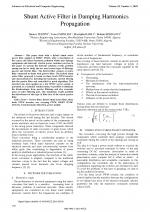| 3/2010 - 18 |
Shunt Active Filter in Damping Harmonics PropagationTEDJINI, H. |
| Extra paper information in |
| Click to see author's profile in |
| Download PDF |
Author keywords
passive filter, hybrid shunt active filter, three levels PWM inverter, two carrying PWM, 500kV HVDC network, total harmonic distortion, power quality
References keywords
power(7), active(6)
Blue keywords are present in both the references section and the paper title.
About this article
Date of Publication: 2010-08-31
Volume 10, Issue 3, Year 2010, On page(s): 108 - 113
ISSN: 1582-7445, e-ISSN: 1844-7600
Digital Object Identifier: 10.4316/AECE.2010.03018
Web of Science Accession Number: 000281805600018
SCOPUS ID: 77956635404
Abstract
This paper deals with a hybrid shunt active power filter applied on 500 kV HVDC, after a description of the causes and effects harmonic pollution which may damage equipments and interrupt electric power customers service; in this paper we present the deferent solutions of this problem among one has to study the two most recent types of filtering: passive and hybrid filter. The hybrid filter consists of active filter connected in shunt with passive filter. The hybrid shunt active filter proposed is based on three levels PWM inverter and characterized by detecting the harmonic current flowing into the passive filter and controlled by notch algorithm. This structure has been applied on a test HVDC power system, is presented as a technical solution makes it possible to eliminate the disadvantages from passive filtering, and also economic price of active filtering part. The simulation results justified the effectiveness of this type of filter face of the classic passive filter. |
| References | | | Cited By «-- Click to see who has cited this paper |
| [1] L. Gyugi & C. Strycula, "Active AC Power Filters," IEEE/IAS '76 Annal Meeting, p. 529, 1976.R
[2] P. Jintakosonwit, H. Fujita, and H. Akagi, "Control and Performance of a Fully Digital Controlled Shunt Active Filter for Installation on a Power Distribution System," IEEE Trans. Power Electronics, vol. 17, no. 1, January 2002, pp. 132-140. [CrossRef] [SCOPUS Times Cited 253] [3] H. Akagi, A. Nabae, and S. Atoh, "Control Strategy of Active Power Filters Using Multiple Voltage-Source PWM Converters," IEEE Transactions on Industrial Applications, vol. 22, no. 3, 1986, pp. 460-465. [CrossRef] [SCOPUS Times Cited 572] [4] M. Saitou, T. Shimizu, "A Novel Strategy of The High Power PWM Inverter With The Series Active Filter", ISIE'2000, Cholula, Puebla, Mexico, pp.67-72. [5] H. Tedjini, "Etude et realisation d'un convertisseur triphase a deux niveau commande par Dspace, pour des applications de commande des systemes electriques", magister thesis, Ibn Khaldoun University Tiaret, 2007. [6] H. Djeghloud, H. Benalla et A. Bentounsi, Filtrage Actif des Systemes de Puissance: Revision de l'Etat de l'Art", International Conference in Electrical Engineering an dits Applications ICEEA, May 2008. [7] P. Mattavelli, "A closed-loop selective harmonic compensation for active filters," IEEE Trans. Ind. Appl., vol. 37, no. 1, pp. 81-89, Jan. 2001. [CrossRef] [SCOPUS Times Cited 467] [8] S. Beaulieu, "Etude et mise au point d'un filtre actif d'harmoniques en vue d'ameliorer la qualite de l'alimentation electrique" .Memoire presente comme exigence partielle de la maîtrise en ingenierie; Universite du Quebec A Chicoutimi Mai 2007. [9] M. Rastogi, N. Mohan, A. Edris' Hybrid-Active Filtering Of Harmonic Currents In Power Systems', IEEE Transactions on Power Delivery, vol. 10, no. 4, October 1995, pp. 1994-2000. [CrossRef] [SCOPUS Times Cited 135] Web of Science® Citations for all references: 0 SCOPUS® Citations for all references: 1,427 TCR Web of Science® Average Citations per reference: 0 SCOPUS® Average Citations per reference: 159 ACR TCR = Total Citations for References / ACR = Average Citations per Reference We introduced in 2010 - for the first time in scientific publishing, the term "References Weight", as a quantitative indication of the quality ... Read more Citations for references updated on 2025-07-02 05:26 in 29 seconds. Note1: Web of Science® is a registered trademark of Clarivate Analytics. Note2: SCOPUS® is a registered trademark of Elsevier B.V. Disclaimer: All queries to the respective databases were made by using the DOI record of every reference (where available). Due to technical problems beyond our control, the information is not always accurate. Please use the CrossRef link to visit the respective publisher site. |
Faculty of Electrical Engineering and Computer Science
Stefan cel Mare University of Suceava, Romania
All rights reserved: Advances in Electrical and Computer Engineering is a registered trademark of the Stefan cel Mare University of Suceava. No part of this publication may be reproduced, stored in a retrieval system, photocopied, recorded or archived, without the written permission from the Editor. When authors submit their papers for publication, they agree that the copyright for their article be transferred to the Faculty of Electrical Engineering and Computer Science, Stefan cel Mare University of Suceava, Romania, if and only if the articles are accepted for publication. The copyright covers the exclusive rights to reproduce and distribute the article, including reprints and translations.
Permission for other use: The copyright owner's consent does not extend to copying for general distribution, for promotion, for creating new works, or for resale. Specific written permission must be obtained from the Editor for such copying. Direct linking to files hosted on this website is strictly prohibited.
Disclaimer: Whilst every effort is made by the publishers and editorial board to see that no inaccurate or misleading data, opinions or statements appear in this journal, they wish to make it clear that all information and opinions formulated in the articles, as well as linguistic accuracy, are the sole responsibility of the author.



